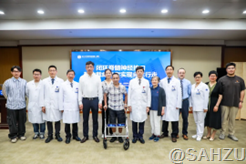
After a devastating fall in October 2024 left Mr. Jin, a 61-year-old man, with a fractured spine and a diagnosis of complete paraplegia, his doctors were blunt: he stood a remote chance of walking again. Four months of rehabilitation yielded little hope. His legs remained motionless.
Today, Mr. Jin walks, not only in a straight line, but with the ability to turn corners, climb stairs, descend slopes, and adjust his pace. His transformation is the outcome of China's first successful implantation of a closed-loop spinal nerve interface, a breakthrough in neuro-engineering led by a team of doctors and researchers at the Second Affiliated Hospital Zhejiang University School of Medicine, Nanhu Brain-computer Interface Institute, Brain-Machine Intelligence Lab, and the College of Biomedical Engineering & Instrument Science.
The surgery, performed in March 2025, involved surgically implanting a spinal cord stimulation electrode with 16 contact points into Mr. Jin's lower spine. A matchbox-sized, wireless stimulator was embedded into his abdomen, functioning much like a mobile phone's wireless charger.
“Just place the coil near the skin and it begins charging—one charge lasts over a week,” said Dr. ZHU Junming, chief neurosurgeon overseeing the procedure. All components, he noted, were domestically developed with fully independent Chinese intellectual property rights.![]()

Within 15 days of the procedure, Mr. Jin could stand and walk unaided. Two months later, he regained basic mobility for everyday life. Even more surprisingly, his lower-limb sensation began to return, along with bowel control and improved urinary function, suggesting the system may also help repair damaged sensory pathways. For China’s estimated 3.7 million people living with spinal cord injuries, the implications could be profound.
To describe the innovation, Dr. Zhu offered a metaphor: “Think of the spinal cord as a highway. Mr. Jin’s injury blocked most of the lanes. Our spinal nerve interface is like a road crew that rebuilt the damaged section, allowing traffic to flow again.”
At the heart of the system is a multi-modal spinal cord stimulation platform, built in partnership with industry collaborators. It combines flexible, implantable electrodes, a wireless EMG signal acquisition unit, and closed-loop feedback software that responds in real time to Mr. Jin’s muscle activity.
Traditional spinal stimulators deliver fixed patterns and are often inadequate in restoring voluntary movement. In contrast, this novel approach integrates precise electrical stimulation, adaptive contact-point configurations, and real-time EMG feedback to mimic more natural movement.
“By tuning the stimulation frequency and intensity based on the patient’s own neural signals, we can restore something closer to a physiological gait,” said Prof. XU Kedi, a biomedical engineer on the team.
This real-time feedback system allows muscle signals to adjust the stimulation as the patient walks, creating a closed-loop in which brain, body, and machine communicate continuously. Personalized rehabilitation protocols tailored to different recovery stages further enhance the effectiveness.
The team views Mr. Jin’s case not as an endpoint, but as the beginning of a broader effort. They are now expanding clinical trials, recruiting new patients, and fine-tuning protocols for broader application.
“This is a disruptive technology at a critical inflection point,” said Dr. WANG Jian’an, a Fellow of the Chinese Academy of Sciences. “In the future, we will continue to foster interdisciplinary collaboration across teams and tackle major scientific challenges, thus contributing the power of Zhejiang University to life and health.”

For Mr. Jin, this technology is deeply personal. Just months ago, daily independence seemed out of reach. Today, he walks—one step at a time—toward a life once thought lost.
Author:Zhejiang University | Reviewer: | Editor: | Source: | Date:2025-05-28 | Views:![]()